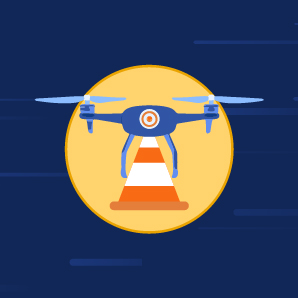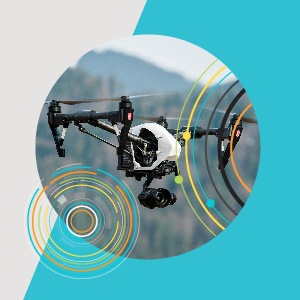Autonomous technology and robotics are having a huge impact on and revolutionizing industries like construction, agriculture, energy, aviation, public safety and infrastructure for the Public Sector. Here is a list of great events you should know about. Carahsoft and our vendor partners are excited to help attendees learn about and adopt solutions in the field of automation and robotics. Join a variety of senior leaders, Government executives, innovators and IT professionals to explore the rapidly advancing field of autonomy and robotics and how it can help your agency or organization advance its strategies and innovation efforts.
AUVSI XPONENTIAL
May 19-22 | Houston, TX | In-Person Event
XPONENTIAL 2025 is the leading global event for uncrewed systems and autonomous technology, bringing together innovators, policymakers and industry leaders to shape the future of autonomy. Attendees will gain valuable insights from over 200 expert-led sessions, explore cutting-edge technologies from 500+ exhibitors and network with 8,500+ professionals from across the air, land and maritime domains. The event offers unparalleled opportunities to discover real-world applications, address regulatory challenges and accelerate the adoption of autonomous solutions across diverse industries. Whether you are driving innovation, navigating policy landscapes or seeking strategic partnerships, XPONENTIAL 2025 is the premier platform to advance your organization’s autonomy strategy.
For a sneak peek into what you can expect at the summit, topics covered during last year’s event included:
- Cybersecurity
- Data and Analytics
- Implementation and Application
- Infrastructure and Operations
- Technical Development and Research
Carahsoft is thrilled to be sponsoring and participating in this event again. We will be featuring two demoing partners at our booth and look forward to sharing details about our reception following the event. Check back for more details closer to the event!
Energy Drone & Robotics Summit
June 16-18 | Houston, TX | In-Person Event
The 9th annual Energy Drone & Robotics Summit is the largest event in the world for unmanned aerial vehicles (UAVs), Robotics, Data, AI and ML, exclusively focused on the business and technology of unmanned systems, automation, data and AI in energy and industrial operations. Offering sessions in UAV and drone operations, maintenance and repair, marine robotics and more, this summit empowers geospatial leaders to adopt, adapt and scale.
Sessions to look out for:
- Energy DataOps: GIS & 3D
- Drone Geophysics & Remote Sensing
- UAV/Drone Ops: Surveying & Mapping
The 2024 Energy Drone & Robotics Summit brought together industry leaders, innovators and tech enthusiasts to explore the latest advancements in unmanned systems, AI and data analytics for energy operations. With cutting-edge demos, insightful panels and hands-on networking, it was a powerhouse event for anyone looking to push the boundaries of automation in the energy sector. While Carahsoft’s involvement is still being finalized, we are planning to have a presence at this year’s event. Stay tuned for updates as we confirm our participation!
Commercial UAV Expo
September 2-4 | Las Vegas, NV | In-Person Event

Commercial UAV Expo 2025 is the leading global event for professionals in the commercial drone industry, bringing together experts, innovators and decision-makers to explore the latest advancements in UAV technology. Attendees will gain valuable insights from over 100 expert-led sessions, discover state of the art solutions from over 200 exhibitors and network with over 3,500 industry professionals from sectors like construction, agriculture, energy, public safety and infrastructure. The event offers a deep dive into critical topics such as drone regulations, AI integration, beyond visual line of sight (BVLOS) operations and real-world case studies showcasing UAV success stories. Whether you are looking to adopt drone technology, optimize operations or stay ahead of industry trends, this expo is the must-attend event for commercial drone professionals.
For a sneak peek into what you can expect at the summit, topics covered during last year’s event included:
- Surveying
- Drone Pilots
- Construction
- Infrastructure
- Energy and Utilities
This year, you can find Carahsoft on the show floor with several of our key Autonomy and Robotics vendors and spend time with us at our reception – more to come. Keep a look out for our reception on our website!
2025 NBAA Business Aviation Convention & Exhibition (NBAA-BACE)
October 14-16 | Las Vegas, NV | In-Person Event
The 2025 National Business Aviation Convention & Exhibition (NBAA-BACE) allows its exhibitors to showcase their latest innovations and services driving the business aviation industry forward. At NBAA-BACE, companies receive unparalleled access to a global audience of decision-makers, industry leaders and potential clients. Exhibitors will have the opportunity to connect with thousands of attendees, expand their reach and elevate their brand in front of key players looking for solutions and partnerships.
Carahsoft is looking forward to attending this year’s event and joining the aviation industry’s decision makers, buyers and brokers at the world’s most influential aviation event. We seek to support the future of aviation through strategic partnerships and innovative technology solutions. By working with industry-leading vendors, we provide government and commercial customers with the tools they need to enhance efficiency, security and sustainability in aviation.
EVTOL Technology USA
October | Arlington, VA | In-Person Event
Drawing on knowledge shared by leading electric vertical take-off and landing (eVTOL) experts, eVTOL Technology USA will facilitate fruitful discussions on industry priorities, challenges and solutions. Through a wide range of presentations, demonstrations and discussion, this event offers a holistic view and seeks to enable the community to access the latest design, innovation and certification developments in the sector. This conference will be a catalyst to furthering these internationally important topics by promoting dedicated discussions, networking and knowledge sharing to enhance approaches, analysis and solutions for the safe integration of eVTOLs in the US and international airspace.
Carahsoft’s involvement in the EVTOL Technology USA event highlights our commitment to advancing next-generation aviation solutions through strategic partnerships and innovative technology. By collaborating with industry leaders and leveraging our extensive ecosystem of partners, we empower Government and commercial customers with cutting-edge eVTOL capabilities that drive efficiency, sustainability and mission success.
Drone and AAM Symposium
July 29-30 | Washington, DC | In-Person Event
The Drone and Advanced Air Mobility (AAM) Symposium brings together representatives from Government agencies, international aviation experts, industry leaders and academia to accelerate advanced operations. Presenters and panelists will discuss the latest information and advancements related to the diverse uses of drones and the safe integration of Advanced Air Mobility aircraft into the National Airspace System.
Carahsoft’s participation in the Drone and AAM Symposium underscores our goal of supporting the future of autonomous and advanced air mobility. Through our strong partnerships with industry leaders, we provide Government and commercial customers with the cutting-edge solutions needed to drive innovation, enhance safety and accelerate adoption in the evolving aerospace landscape.
Previous Event Highlights:
GeoWeek
GeoWeek united geospatial and mapping professionals to explore how data, maps and advanced technologies can deepen our understanding of the world and inform solutions for complex challenges this year in Denver, CO. Attendees had the chance to discover cutting-edge developments in 3D technology, airborne and terrestrial surveying methods and Building Information Modeling (BIM). GeoWeek showcases over 200 exhibitors’ cutting-edge solutions, providing a comprehensive platform for comparing and qualifying technologies that are transforming various industries. In addition to the exhibition, GeoWeek offers practical, actionable education sessions led by industry experts, focusing on the integration of geospatial data, workflow optimization and software standards. This convergence of technology and knowledge-sharing positions GeoWeek at the forefront of industry innovation.
Sessions covered:
- Rescue, Recovery and Rebuild by Francis Scott Key Bridge
- 3D, AI/ML and Event-Driven Architecture in Action by DFW Airport’s Digital Evolution
At this year’s show, Carahsoft’s booth featured live demos from two of our partners, Tomorrow.io and Reveal Technologies. We eagerly showcase innovative technologies for our customers and look forward to participating again at next year’s conference.
Army Worldwide Security Assistance Conference (AWSAC)
AUVSI’s AWSAC event brings together the ASAE and U.S. industry with opportunities for collaboration, transparent discourse, professional development and innovative ideas to reshape the future of Army security assistance. This three-day event is designed to provide a deep dive into the landscape of security assistance, defense innovation and the United States industrial base.
Sessions covered:
- Best Practices on the Job | Program Management Best Practices: What Army acquisition best practices to apply to FMS on the ground
- Integrating FMS into Army Modernization | Drive Partnership Across Security Cooperation and Modernization
- Workforce Professionalization | Impact of Workforce Reform
Carahsoft proudly represented a 3-star sponsorship at this year’s AUVSI AWSAC event. Attendees had the opportunity to stop by our table and speak with a defense solutions procurement expert.
Drone Responders National Public Safety UAS Conference
The Drone Responders National Public Safety UAS Conference is a key annual event dedicated to the use of unmanned aircraft systems (UAS) by public safety professionals. This conference serves as a hub for sharing knowledge, best practices and innovative solutions tailored to the unique needs of first responders and public safety agencies, as well as a space to promote the education of UAS safety.
Sessions covered:
- Hurricane Responses
- Exciting New Public Safety FAA Waivers
- Law Enforcement Tactical, Detection and Mitigation
Carahsoft is excited to have sponsored and attended this year’s conference! As a Gold sponsor, we met with attendees at our booth sharing more about our Autonomy and Robotic Technology offerings and how to become a vendor.
Industry and Government collaborations enable Carahsoft to offer a comprehensive range of autonomy and robotics technology solutions and services to the Public Sector. By leveraging the strengths of these companies, Carahsoft ensures that Government agencies have access to cutting-edge technology for search and rescue, mapping and surveying and disaster response.
To learn more or get involved in any of the above events, please contact us at AutonomousTech@Carahsoft.com. For more information on Carahsoft and our industry leading Autonomy and Robotics technology partners’ events, visit our Autonomy and Robotics solutions portfolio.

 In December 2015, the Chula Vista Police Department (CVPD) established the Unmanned Aircraft Systems (UAS) Committee with the primary aim of evaluating the integration of UAS into its public safety operations.
In December 2015, the Chula Vista Police Department (CVPD) established the Unmanned Aircraft Systems (UAS) Committee with the primary aim of evaluating the integration of UAS into its public safety operations. But some hackers have the expertise to bypass this first line of defense. To combat this, military units must layer in more advanced measures. For example, snap-on deception technology can obscure the location of a drone and pilot. In addition, if a drone is lost or captured, cyber-hardening modules can protect against data exfiltration, erase log files, and shut the drone down.
But some hackers have the expertise to bypass this first line of defense. To combat this, military units must layer in more advanced measures. For example, snap-on deception technology can obscure the location of a drone and pilot. In addition, if a drone is lost or captured, cyber-hardening modules can protect against data exfiltration, erase log files, and shut the drone down.